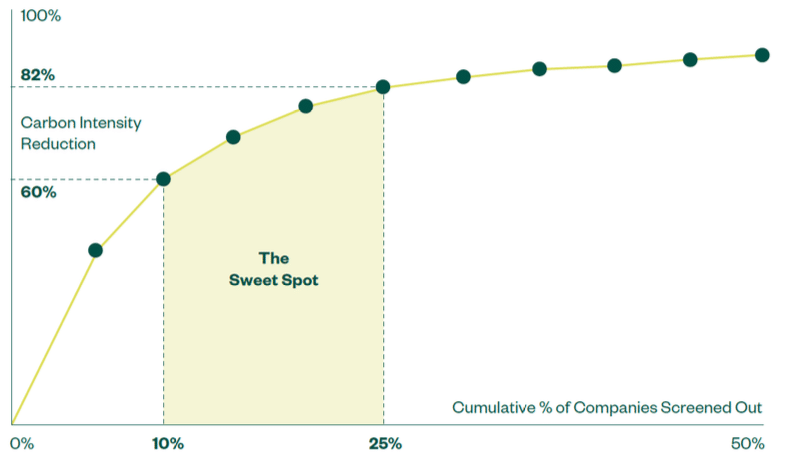Hitting the Sweet Spot on the Carbon Reduction Curve
By Rupert Cadbury of State Street Global Advisors:
Achieving Lower Carbon with Familiar Returns
We are helping investors understand, control and benefit from the quantifiable trade-offs between carbon reduction and tracking error. Most importantly, we are demonstrating that significant improvements in carbon intensity can be achieved with minimal impact to credit quality or interest-rate risk relative to corporate bond benchmarks.
Solving the Climate Data Challenge
Reducing a portfolio’s carbon intensity starts with being able to measure carbon emissions for each issuer, and this has been a major challenge for fixed income managers.
It’s well documented that data providers’ information about carbon emissions and other environmental, social and governance (ESG) factors is less extensive for fixed income than for equities. Historically, ESG data providers have built their coverage based on listings of publicly traded equities.
This has proved to be problematic for two reasons:
- It excludes bond issuers that don’t have publicly listed equity shares.
- Given that some companies have hundreds of bond issuances and the codes used for identifying bonds are complex and inconsistent, translating information from the equity universe to the fixed income universe is challenging. Mergers of issuers make this exercise even more difficult.
At State Street, we have devoted an incredible amount of energy into solving these challenges. We have built a proprietary framework based on multiple sources of best-in-class data that maps information about a company’s carbon emissions and other climate and ESG data from equities to fixed income. Our framework provides reliable coverage for approximately 85% to 95% of the corporate bond universe in developed markets, depending on the region.
This data provides the foundation of our efforts to guide investors through the process of understanding the tradeoffs between tracking error and carbon reduction at varying levels of exclusions.
Right Data, Right Decisions
This clean data provides the foundation of our efforts to guide investors through the process of understanding the trade-offs between tracking error and carbon reduction at varying levels of exclusions.
Hitting the Sweet Spot
Carbon emissions are concentrated among a relatively small percentage of bond issuers. This means that a corporate bond portfolio’s carbon footprint can be reduced by more than 80% by excluding the top quartile of the heaviest polluters.
The carbon reduction curve is steep initially; then, there are diminishing returns. Our research showed that, similar to equities, carbon intensity among corporate bonds is concentrated among a relatively small number of companies. As a result, screening out a small percentage of the heaviest-polluting companies leads to significant reductions in carbon intensity.
The “sweet spot” is likely in the 10% to 30% exclusion range. Given the steepness of the carbon reduction curve and its diminishing returns, the “sweet spot” in the tradeoff between carbon reduction and tracking error is likely found between excluding 10% to 30% of the heaviest polluters. Where a specific investor ends up within this range depends on their specific climate-related objectives and their risk budget.
Based on our data, many investors have expressed interest in 15% screening, which results in a 70% reduction in carbon intensity with only minimal deviation from the Bloomberg Barclays Euro Corporate Bond Index. Within this range, there is also relatively low impact on credit quality and interest-rate risk exposure.
Unsurprisingly, screening out the heaviest-polluting companies introduces a degree of sector bias, tilting the portfolio away from utilities and toward financials. Our research found that this effect is gradual, but it is something that investors should still consider as they determine the level of screening that is appropriate for them.

Moving From Guidance to Implementation
In addition to helping investors determine the optimal position on the carbon reduction curve, we also guide them through the process of implementing the Low-Carbon Corporate Bond Strategy.
The strategy is customizable based on the level of targeted carbon reduction and the index used as the benchmark; the available benchmarks include any corporate bond index in developed markets. We also work with clients to identify any bespoke constraints they want applied to their portfolio, such as additional screens for controversial weapons, tobacco, firearms or noncompliance with the United Nations’ Principles for Responsible Investment.
With any fixed income portfolio, liquidity, turnover and transaction costs are paramount. The Low-Carbon Corporate Bond Strategy aligns well with these concerns. Because the targeted carbon intensity reductions can be achieved with low levels of exclusions, investors don’t need to renormalize and rebalance large portions of the portfolio.
Furthermore, our historical research found that the list of companies included among the ranks of the heaviest polluters doesn’t change much over time, limiting the amount of monthly turnover in the index.
Another way we look to minimize transaction costs is by participating in new bond issuances when possible. This tactic allows us to capitalize on the slight discount that often is applied before bonds begin trading on the secondary market.
Whether through the Low-Carbon Corporate Bond Strategy or other strategies, our deep knowledge of fixed income market structures and indexing allow us to skilfully implement customized portfolios for our clients in the most efficient way possible.
Introducing the Low-Carbon Corporate Bond Strategy
We’ve taken the best of our research and our new data framework to develop our Low- Carbon Corporate Bond strategy.
Using this strategy we can now create customized portfolios for clients that have significantly lower carbon footprints but nonetheless produce similar returns to their selected fixed income benchmarks. The strategy is available now to help investors reach their goals for reducing carbon emissions without compromising their investment objectives.
Discover More
Learn how our ESG strategies could help you meet the climate change challenge and more. Please visit ssga.com/esg for case studies and further information.
This article featured in HedgeNordic’s Special Report on “Alternative Fixed Income.”